jenkins:集成sonar代码扫描+发送邮件
前提:
Jenkins
JDK
目录:
1、安装sonar插件:SonarQube Scanner for Jenkins
2、安装SonarQube
3、安装sonar-scanner
+++++++++++++++++++++++++++++++++++++++++++++++++++++++++++++++++++++++++++++++++++++++++++++++++++++++++++++++++++++++++++++++++++++++++++++++++++++++++++++++++++++++++++++++++++++++++++++++++++++++++++
1.安装sonar插件:SonarQube Scanner for Jenkins

2、安装SonarQube,并配置mysql数据库
2.1 下载
下载地址:https://www.sonarqube.org/downloads/
2.2 解压
下载后放在/usr/local目录下,并解压
unzip sonarqube-7.4.zip
2.3 配置环境变量
vi /etc/profile
里面写如下
#set sonarqube
export SONAR_HOME=/usr/local/sonarqube-7.4
PATH=$PATH:$SONAR_HOME/bin
使配置生效
source /etc/profile
2.4 启动并测试
进入到启动目录
/usr/local/sonarqube-7.4/bin/linux-x86-64
执行启动命令
./sonar.sh start
启动时要查看es.log和sonar.log日志,还有web.log,关于数据库配置的错误会在此处显示
tail -f /usr/local/sonarqube-6.7.6/logs/es.log
tail -f /usr/local/sonarqube-6.7.6/logs/sonar.log
tail -f /usr/local/sonarqube-6.7./logs/web.log
用root启动会报错,请参考我的另一篇文章:https://www.cnblogs.com/gcgc/p/10239590.html
所有问题解决完后启动,并测试,访问ip+port,OK了
如果默认的9000端口被占用了,则修改默认端口 vi /usr/local/sonarqube-7.4/conf/sonar.properties
注意sonar中还集成了elastic search默认端口为9001,所以要查看9001否也被占用lsof -i:9001,如果被占用,也是修改上面的文件
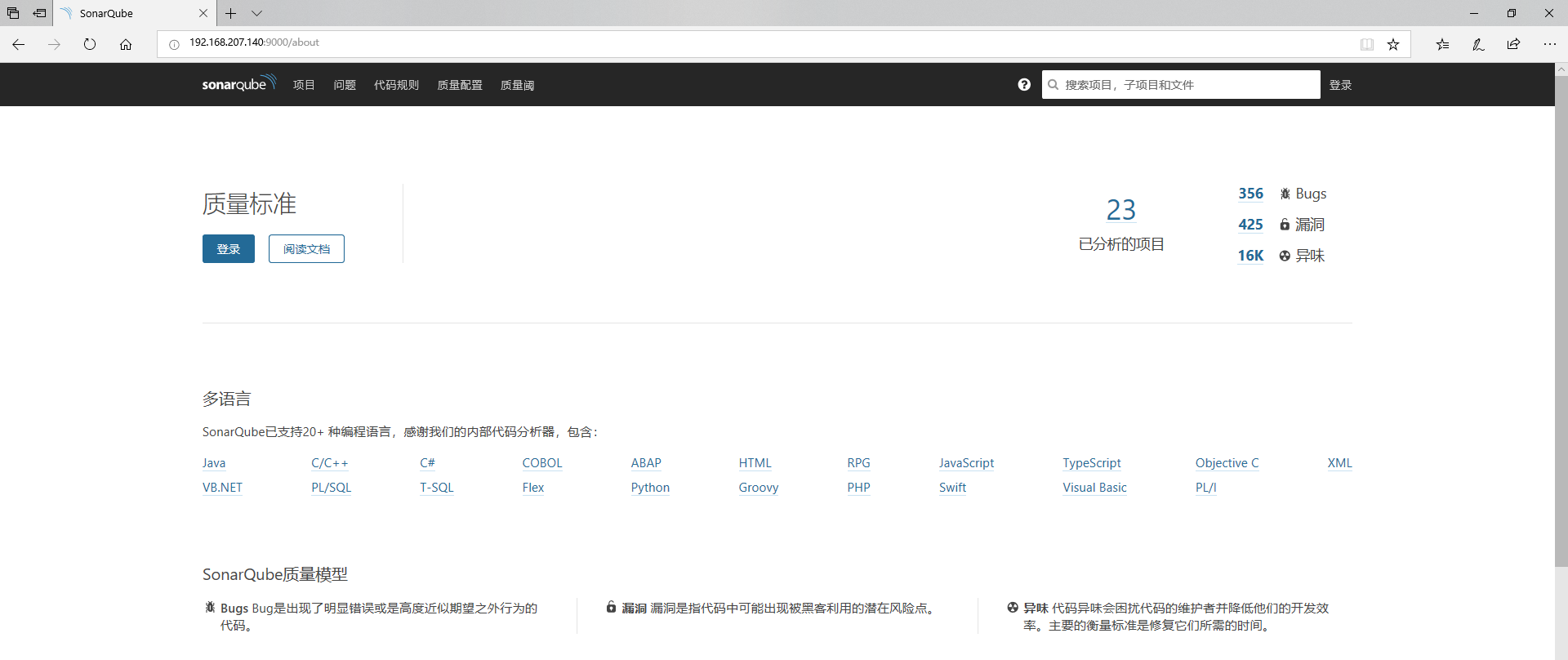
2.5 sonar配置mysql数据库
sonar自带测试数据库,但是具体应用还是的换其他数据,这里我们使用mysql,
创建sonar数据库
DROP DATABASE sonar; CREATE DATABASE sonar CHARACTER SET utf8 COLLATE utf8_general_ci; CREATE USER 'sonar' IDENTIFIED BY 'sonar'; GRANT ALL ON sonar.* TO 'sonar'@'%' IDENTIFIED BY 'sonar'; GRANT ALL ON sonar.* TO 'sonar'@'localhost' IDENTIFIED BY 'sonar'; FLUSH PRIVILEGES;

2.6 修改配置文件
修改vi /usr/local/sonarqube-7.4/conf/sonar.properties文件,如下的蓝色加粗字体
# Property values can:
# - reference an environment variable, for example sonar.jdbc.url= ${env:SONAR_JDBC_URL}
# - be encrypted. See https://redirect.sonarsource.com/doc/settings-encryption.html #--------------------------------------------------------------------------------------------------
# DATABASE
#
# IMPORTANT:
# - The embedded H2 database is used by default. It is recommended for tests but not for
# production use. Supported databases are MySQL, Oracle, PostgreSQL and Microsoft SQLServer.
# - Changes to database connection URL (sonar.jdbc.url) can affect SonarSource licensed products. # User credentials.
# Permissions to create tables, indices and triggers must be granted to JDBC user.
# The schema must be created first.
#sonar.jdbc.username=
#sonar.jdbc.password= sonar.jdbc.username=sonar
sonar.jdbc.password=sonar sonar.sorceEncoding=UTF-8
sonar.login=admin
sonar.password=admin #----- Embedded Database (default)
# H2 embedded database server listening port, defaults to
#sonar.embeddedDatabase.port= #----- DEPRECATED
#----- MySQL >=5.6 && <8.0
# Support of MySQL is dropped in Data Center Editions and deprecated in all other editions
# Only InnoDB storage engine is supported (not myISAM).
# Only the bundled driver is supported. It can not be changed.
sonar.jdbc.url=jdbc:mysql://192.168.207.160:3306/sonar?useUnicode=true&characterEncoding=utf8&rewriteBatchedStatements=true&useConfigs=maxPerformance&useSSL=false #----- Oracle 11g/12c
# The Oracle JDBC driver must be copied into the directory extensions/jdbc-driver/oracle/.
# Only the thin client is supported, and only the versions 11.2.x or 12.2.x must be used. See
# https://jira.sonarsource.com/browse/SONAR-9758 for more details.
# If you need to set the schema, please refer to http://jira.sonarsource.com/browse/SONAR-5000
#sonar.jdbc.url=jdbc:oracle:thin:@localhost:/XE #----- PostgreSQL 9.3 or greater
# By default the schema named "public" is used. It can be overridden with the parameter "currentSchema".
#sonar.jdbc.url=jdbc:postgresql://localhost/sonarqube?currentSchema=my_schema #----- Microsoft SQLServer / and SQL Azure
# A database named sonar must exist and its collation must be case-sensitive (CS) and accent-sensitive (AS)
# Use the following connection string if you want to use integrated security with Microsoft Sql Server
# Do not set sonar.jdbc.username or sonar.jdbc.password property if you are using Integrated Security
# For Integrated Security to work, you have to download the Microsoft SQL JDBC driver package from
# https://www.microsoft.com/en-us/download/details.aspx?id=55539
# and copy sqljdbc_auth.dll to your path. You have to copy the bit or bit version of the dll
# depending upon the architecture of your server machine.
#sonar.jdbc.url=jdbc:sqlserver://localhost;databaseName=sonar;integratedSecurity=true # Use the following connection string if you want to use SQL Auth while connecting to MS Sql Server.
# Set the sonar.jdbc.username and sonar.jdbc.password appropriately.
#sonar.jdbc.url=jdbc:sqlserver://localhost;databaseName=sonar #----- Connection pool settings
# The maximum number of active connections that can be allocated
# at the same time, or negative for no limit.
# The recommended value is 1.2 * max sizes of HTTP pools. For example if HTTP ports are
# enabled with default sizes (, see property sonar.web.http.maxThreads)
# then sonar.jdbc.maxActive should be 1.2 * = .
#sonar.jdbc.maxActive= # The maximum number of connections that can remain idle in the
# pool, without extra ones being released, or negative for no limit.
#sonar.jdbc.maxIdle= # The minimum number of connections that can remain idle in the pool,
# without extra ones being created, or zero to create none.
#sonar.jdbc.minIdle= # The maximum number of milliseconds that the pool will wait (when there
# are no available connections) for a connection to be returned before
# throwing an exception, or <= to wait indefinitely.
#sonar.jdbc.maxWait= #sonar.jdbc.minEvictableIdleTimeMillis=
#sonar.jdbc.timeBetweenEvictionRunsMillis= #--------------------------------------------------------------------------------------------------
# WEB SERVER
# Web server is executed in a dedicated Java process. By default heap size is 512Mb.
# Use the following property to customize JVM options.
# Recommendations:
#
# The HotSpot Server VM is recommended. The property -server should be added if server mode
# is not enabled by default on your environment:
# http://docs.oracle.com/javase/8/docs/technotes/guides/vm/server-class.html
#
# Startup can be long if entropy source is short of entropy. Adding
# -Djava.security.egd=file:/dev/./urandom is an option to resolve the problem.
# See https://wiki.apache.org/tomcat/HowTo/FasterStartUp#Entropy_Source
#
#sonar.web.javaOpts=-Xmx512m -Xms128m -XX:+HeapDumpOnOutOfMemoryError # Same as previous property, but allows to not repeat all other settings like -Xmx
#sonar.web.javaAdditionalOpts= # Binding IP address. For servers with more than one IP address, this property specifies which
# address will be used for listening on the specified ports.
# By default, ports will be used on all IP addresses associated with the server.
#sonar.web.host=0.0.0.0 # Web context. When set, it must start with forward slash (for example /sonarqube).
# The default value is root context (empty value).
#sonar.web.context=
# TCP port for incoming HTTP connections. Default value is .
sonar.web.port=9000 # The maximum number of connections that the server will accept and process at any given time.
# When this number has been reached, the server will not accept any more connections until
# the number of connections falls below this value. The operating system may still accept connections
# based on the sonar.web.connections.acceptCount property. The default value is .
#sonar.web.http.maxThreads= # The minimum number of threads always kept running. The default value is .
#sonar.web.http.minThreads= # The maximum queue length for incoming connection requests when all possible request processing
# threads are in use. Any requests received when the queue is full will be refused.
# The default value is .
#sonar.web.http.acceptCount= # By default users are logged out and sessions closed when server is restarted.
# If you prefer keeping user sessions open, a secret should be defined. Value is
# HS256 key encoded with base64. It must be unique for each installation of SonarQube.
# Example of command-line:
# echo -n "type_what_you_want" | openssl dgst -sha256 -hmac "key" -binary | base64
#sonar.auth.jwtBase64Hs256Secret= # The inactivity timeout duration of user sessions, in minutes. After the configured
# period of time, the user is logged out.
# The default value is set to days ( minutes)
# and cannot be greater than months. Value must be strictly positive.
#sonar.web.sessionTimeoutInMinutes= # A passcode can be defined to access some web services from monitoring
# tools without having to use the credentials of a system administrator.
# Check the Web API documentation to know which web services are supporting this authentication mode.
# The passcode should be provided in HTTP requests with the header "X-Sonar-Passcode".
# By default feature is disabled.
#sonar.web.systemPasscode= #--------------------------------------------------------------------------------------------------
# SSO AUTHENTICATION # Enable authentication using HTTP headers
#sonar.web.sso.enable=false # Name of the header to get the user login.
# Only alphanumeric, '.' and '@' characters are allowed
#sonar.web.sso.loginHeader=X-Forwarded-Login # Name of the header to get the user name
#sonar.web.sso.nameHeader=X-Forwarded-Name # Name of the header to get the user email (optional)
#sonar.web.sso.emailHeader=X-Forwarded-Email # Name of the header to get the list of user groups, separated by comma (optional).
# If the sonar.sso.groupsHeader is set, the user will belong to those groups if groups exist in SonarQube.
# If none of the provided groups exists in SonarQube, the user will only belong to the default group.
# Note that the default group will always be set.
#sonar.web.sso.groupsHeader=X-Forwarded-Groups # Interval used to know when to refresh name, email and groups.
# During this interval, if for instance the name of the user is changed in the header, it will only be updated after X minutes.
#sonar.web.sso.refreshIntervalInMinutes= #--------------------------------------------------------------------------------------------------
# LDAP CONFIGURATION # Enable the LDAP feature
# sonar.security.realm=LDAP # Set to true when connecting to a LDAP server using a case-insensitive setup.
# sonar.authenticator.downcase=true # URL of the LDAP server. Note that if you are using ldaps, then you should install the server certificate into the Java truststore.
# ldap.url=ldap://localhost:10389 # Bind DN is the username of an LDAP user to connect (or bind) with. Leave this blank for anonymous access to the LDAP directory (optional)
# ldap.bindDn=cn=sonar,ou=users,o=mycompany # Bind Password is the password of the user to connect with. Leave this blank for anonymous access to the LDAP directory (optional)
# ldap.bindPassword=secret # Possible values: simple | CRAM-MD5 | DIGEST-MD5 | GSSAPI See http://java.sun.com/products/jndi/tutorial/ldap/security/auth.html (default: simple)
# ldap.authentication=simple # See :
# * http://java.sun.com/products/jndi/tutorial/ldap/security/digest.html
# * http://java.sun.com/products/jndi/tutorial/ldap/security/crammd5.html
# (optional)
# ldap.realm=example.org # Context factory class (optional)
# ldap.contextFactoryClass=com.sun.jndi.ldap.LdapCtxFactory # Enable usage of StartTLS (default : false)
# ldap.StartTLS=true # Follow or not referrals. See http://docs.oracle.com/javase/jndi/tutorial/ldap/referral/jndi.html (default: true)
# ldap.followReferrals=false # USER MAPPING # Distinguished Name (DN) of the root node in LDAP from which to search for users (mandatory)
# ldap.user.baseDn=cn=users,dc=example,dc=org # LDAP user request. (default: (&(objectClass=inetOrgPerson)(uid={login})) )
# ldap.user.request=(&(objectClass=user)(sAMAccountName={login})) # Attribute in LDAP defining the user’s real name. (default: cn)
# ldap.user.realNameAttribute=name # Attribute in LDAP defining the user’s email. (default: mail)
# ldap.user.emailAttribute=email # GROUP MAPPING # Distinguished Name (DN) of the root node in LDAP from which to search for groups. (optional, default: empty)
# ldap.group.baseDn=cn=groups,dc=example,dc=org # LDAP group request (default: (&(objectClass=groupOfUniqueNames)(uniqueMember={dn})) )
# ldap.group.request=(&(objectClass=group)(member={dn})) # Property used to specifiy the attribute to be used for returning the list of user groups in the compatibility mode. (default: cn)
# ldap.group.idAttribute=sAMAccountName #--------------------------------------------------------------------------------------------------
# COMPUTE ENGINE
# The Compute Engine is responsible for processing background tasks.
# Compute Engine is executed in a dedicated Java process. Default heap size is 512Mb.
# Use the following property to customize JVM options.
# Recommendations:
#
# The HotSpot Server VM is recommended. The property -server should be added if server mode
# is not enabled by default on your environment:
# http://docs.oracle.com/javase/8/docs/technotes/guides/vm/server-class.html
#
#sonar.ce.javaOpts=-Xmx512m -Xms128m -XX:+HeapDumpOnOutOfMemoryError # Same as previous property, but allows to not repeat all other settings like -Xmx
#sonar.ce.javaAdditionalOpts= #--------------------------------------------------------------------------------------------------
# ELASTICSEARCH
# Elasticsearch is used to facilitate fast and accurate information retrieval.
# It is executed in a dedicated Java process. Default heap size is 512Mb.
#
# --------------------------------------------------
# Word of caution for Linux users on 64bits systems
# --------------------------------------------------
# Please ensure Virtual Memory on your system is correctly configured for Elasticsearch to run properly
# (see https://www.elastic.co/guide/en/elasticsearch/reference/5.5/vm-max-map-count.html for details).
#
# When SonarQube runs standalone, a warning such as the following may appear in logs/es.log:
# "max virtual memory areas vm.max_map_count [65530] is too low, increase to at least [262144]"
# When SonarQube runs as a cluster, however, Elasticsearch will refuse to start.
# # JVM options of Elasticsearch process
#sonar.search.javaOpts=-Xms512m -Xmx512m -XX:+HeapDumpOnOutOfMemoryError # Same as previous property, but allows to not repeat all other settings like -Xmx
#sonar.search.javaAdditionalOpts= # Elasticsearch port. Default is . Use to get a free port.
# As a security precaution, should be blocked by a firewall and not exposed to the Internet.
sonar.search.port=9002 # Elasticsearch host. The search server will bind this address and the search client will connect to it.
# Default is loopback address.
# As a security precaution, should NOT be set to a publicly available address.
#sonar.search.host= #--------------------------------------------------------------------------------------------------
# UPDATE CENTER # Update Center requires an internet connection to request https://update.sonarsource.org
# It is enabled by default.
#sonar.updatecenter.activate=true # HTTP proxy (default none)
#http.proxyHost=
#http.proxyPort=
# HTTPS proxy (defaults are values of http.proxyHost and http.proxyPort)
#https.proxyHost=
#https.proxyPort= # NT domain name if NTLM proxy is used
#http.auth.ntlm.domain= # SOCKS proxy (default none)
#socksProxyHost=
#socksProxyPort= # Proxy authentication (used for HTTP, HTTPS and SOCKS proxies)
#http.proxyUser=
#http.proxyPassword= #--------------------------------------------------------------------------------------------------
# LOGGING # SonarQube produces logs in logs files located in the same directory (see property sonar.path.logs below),
# one per process:
# Main process (aka. App) logs in sonar.log
# Web Server (aka. Web) logs in web.log
# Compute Engine (aka. CE) logs in ce.log
# Elasticsearch (aka. ES) logs in es.log
#
# All files follow the same rolling policy (see sonar.log.rollingPolicy and sonar.log.maxFiles) but it applies
# individually (eg. if sonar.log.maxFiles=, there can be at most of each files, ie. files in total).
#
# All files have logs in the same format:
#
# |-----------------| |---| |-|--------------------||------------------------------| |------------------------------------------------------------------------------------------------------------------------------|
# 2016.11. :: INFO ce[AVht0dNXFcyiYejytc3m][o.s.s.c.t.CeWorkerCallableImpl] Executed task | project=org.sonarqube:example-java-maven | type=REPORT | id=AVht0dNXFcyiYejytc3m | submitter=admin | time=1699ms
#
# : timestamp. Format is YYYY.MM.DD HH:MM:SS
# YYYY: year on digits
# MM: month on digits
# DD: day on digits
# HH: hour of day on digits in hours format
# MM: minutes on digits
# SS: seconds on digits
# : log level.
# Possible values (in order of descending criticality): ERROR, WARN, INFO, DEBUG and TRACE
# : process identifier. Possible values: app (main), web (Web Server), ce (Compute Engine) and es (Elasticsearch)
# : SQ thread identifier. Can be empty.
# In the Web Server, if present, it will be the HTTP request ID.
# In the Compute Engine, if present, it will be the task ID.
# : logger name. Usually a class canonical name.
# Package names are truncated to keep the whole field to characters max
# : log payload. Content of this field does not follow any specific format, can vary in length and include line returns.
# Some logs, however, will follow the convention to provide data in payload in the format " | key=value"
# Especially, log of profiled pieces of code will end with " | time=XXXXms". # Global level of logs (applies to all processes).
# Supported values are INFO (default), DEBUG and TRACE
#sonar.log.level=INFO # Level of logs of each process can be controlled individually with their respective properties.
# When specified, they overwrite the level defined at global level.
# Supported values are INFO, DEBUG and TRACE
#sonar.log.level.app=INFO
#sonar.log.level.web=INFO
#sonar.log.level.ce=INFO
#sonar.log.level.es=INFO # Path to log files. Can be absolute or relative to installation directory.
# Default is <installation home>/logs
#sonar.path.logs=logs # Rolling policy of log files
# - based on time if value starts with "time:", for example by day ("time:yyyy-MM-dd")
# or by month ("time:yyyy-MM")
# - based on size if value starts with "size:", for example "size:10MB"
# - disabled if value is "none". That needs logs to be managed by an external system like logrotate.
#sonar.log.rollingPolicy=time:yyyy-MM-dd # Maximum number of files to keep if a rolling policy is enabled.
# - maximum value is on size rolling policy
# - unlimited on time rolling policy. Set to zero to disable old file purging.
#sonar.log.maxFiles= # Access log is the list of all the HTTP requests received by server. If enabled, it is stored
# in the file {sonar.path.logs}/access.log. This file follows the same rolling policy as other log file
# (see sonar.log.rollingPolicy and sonar.log.maxFiles).
#sonar.web.accessLogs.enable=true # Format of access log. It is ignored if sonar.web.accessLogs.enable=false. Possible values are:
# - "common" is the Common Log Format, shortcut to: %h %l %u %user %date "%r" %s %b
# - "combined" is another format widely recognized, shortcut to: %h %l %u [%t] "%r" %s %b "%i{Referer}" "%i{User-Agent}"
# - else a custom pattern. See http://logback.qos.ch/manual/layouts.html#AccessPatternLayout.
# The login of authenticated user is not implemented with "%u" but with "%reqAttribute{LOGIN}" (since version 6.1).
# The value displayed for anonymous users is "-".
# The SonarQube's HTTP request ID can be added to the pattern with "%reqAttribute{ID}" (since version 6.2).
# If SonarQube is behind a reverse proxy, then the following value allows to display the correct remote IP address:
#sonar.web.accessLogs.pattern=%i{X-Forwarded-For} %l %u [%t] "%r" %s %b "%i{Referer}" "%i{User-Agent}" "%reqAttribute{ID}"
# Default value (which was "combined" before version 6.2) is equivalent to "combined + SQ HTTP request ID":
#sonar.web.accessLogs.pattern=%h %l %u [%t] "%r" %s %b "%i{Referer}" "%i{User-Agent}" "%reqAttribute{ID}" #--------------------------------------------------------------------------------------------------
# OTHERS # Delay in seconds between processing of notification queue. Default is seconds.
#sonar.notifications.delay= # Paths to persistent data files (embedded database and search index) and temporary files.
# Can be absolute or relative to installation directory.
# Defaults are respectively <installation home>/data and <installation home>/temp
#sonar.path.data=data
#sonar.path.temp=temp # Telemetry - Share anonymous SonarQube statistics
# By sharing anonymous SonarQube statistics, you help us understand how SonarQube is used so we can improve the product to work even better for you.
# We don't collect source code or IP addresses. And we don't share the data with anyone else.
# To see an example of the data shared: login as a global administrator, call the WS api/system/info and check the Statistics field.
#sonar.telemetry.enable=true #--------------------------------------------------------------------------------------------------
# DEVELOPMENT - only for developers
# The following properties MUST NOT be used in production environments. # Elasticsearch HTTP connector
#sonar.search.httpPort=-
重新启动sonar,好了测试一下

3、安装sonar-scanner
3.1 下载
https://docs.sonarqube.org/display/SCAN/Analyzing+with+SonarQube+Scanner
3.2 解压
下载后放在/usr/local目录下,并解压
unzip sonar-scanner-cli-3.2.0.1227-linux.zip
3.3 配置环境变量
和上面一样修改/etc/profile文件,修改完记得 source /etc/profile
#set sonarqube
export SONAR_HOME=/usr/local/sonarqube-7.4
export SONAR_SCANNER_HOME=/usr/local/sonar-scanner-3.2.0.1227-linux
PATH=$PATH:$SONAR_HOME/bin:$SONAR_SCANNER_HOME/bin
修改完记得 source /etc/profile
3.4 测试
进入/usr/local/sonar-scanner-3.2.0.1227-linux/bin执行:
./sonar-scanner -h
如果出现如下就说明安装好了
[root@iZbp1bb2egi7w0ueys548qZ bin]# ./sonar-scanner -h
INFO:
INFO: usage: sonar-scanner [options]
INFO:
INFO: Options:
INFO: -D,--define <arg> Define property
INFO: -h,--help Display help information
INFO: -v,--version Display version information
INFO: -X,--debug Produce execution debug output
4、在Jenkins中配置sonar
SonarScanner和SonarQube的关系类似于客户端与服务端,由于SonarScanner工具需要把扫描的代码及结果发送到SonarQube服务器上,所以需要配置SonarQube服务地址。
在Jenkins系统配置>>系统设置中配置如下:

5、在Jenkins中配置sonar-scanner
在全局工具配置中配置如下:

6、增加构建步骤
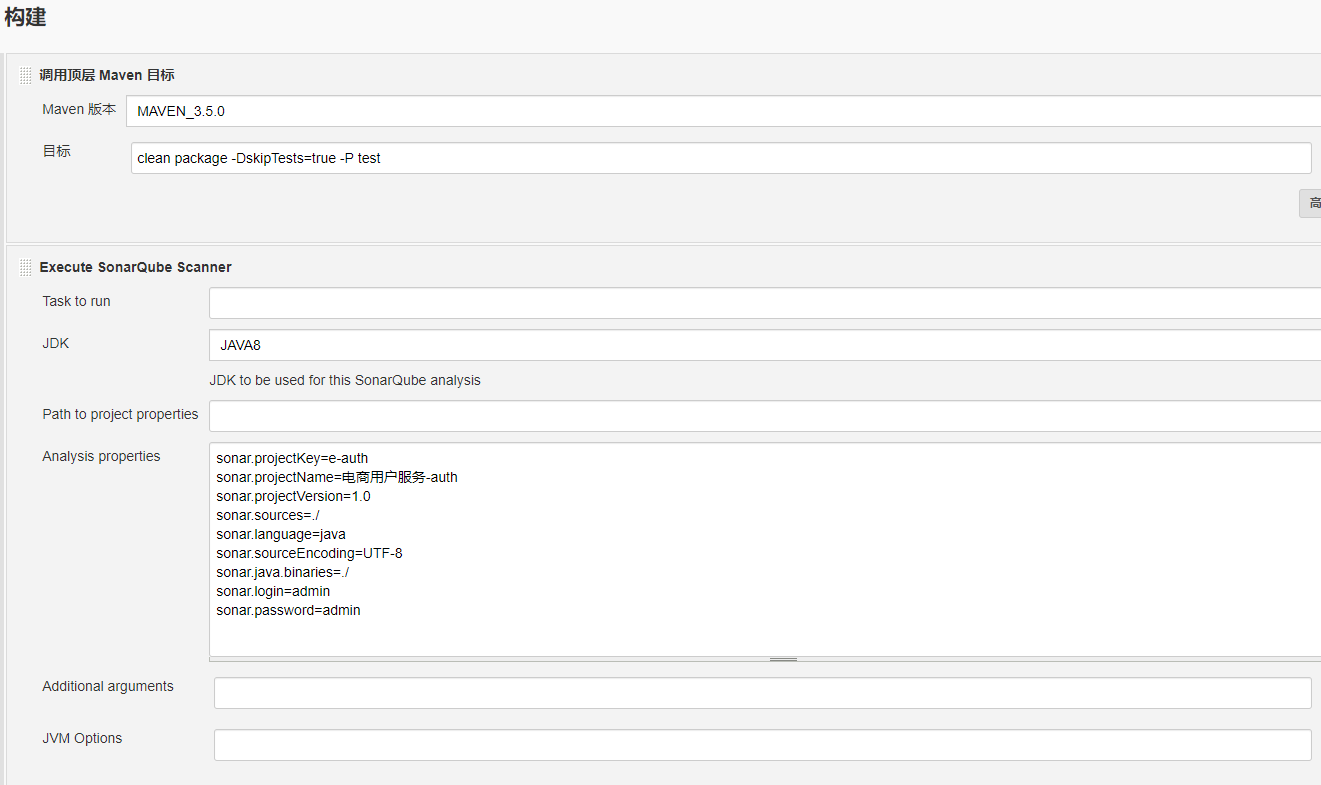
Analysis properties 内容如下
sonar.projectKey=e-auth
sonar.projectName=电商用户服务-auth
sonar.projectVersion=1.0
sonar.sources=./
sonar.language=java
sonar.sourceEncoding=UTF-
sonar.java.binaries=./
sonar.login=admin
sonar.password=admin
7、构建一下

8、添加自定义邮件模板
在jenkins所在机器上/root/.jenkins目录下,新建/sonar_script文件夹,里面放如下脚本:sonar.py和table.html
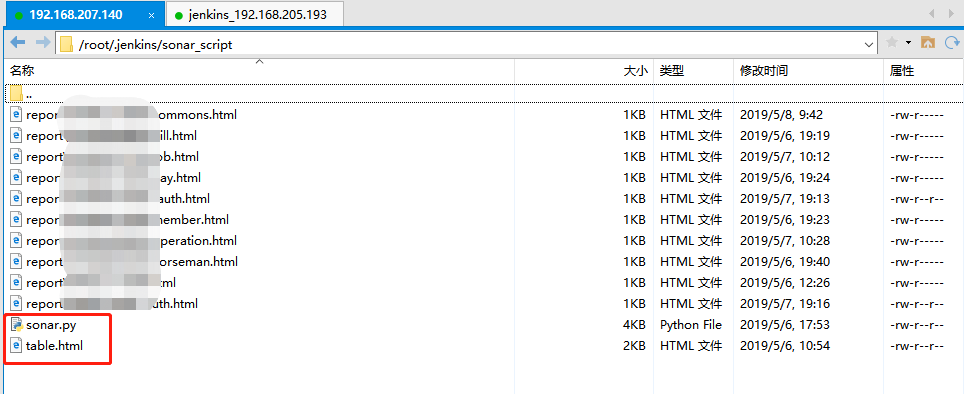
sonar.py内容如下
#!/usr/bin/python
# -*- coding:utf-8 -*- import pymysql,os,sys
from jinja2 import FileSystemLoader,Environment def select_project_uuid(project_name):
db = pymysql.connect(host="192.168.207.160", port=3306, user="sonar", passwd="sonar", db="sonar")
cursor = db.cursor()
select_p_uuid="SELECT project_uuid,kee FROM projects WHERE `name`= '%s'" %(project_name)
cursor.execute(select_p_uuid)
result = cursor.fetchone()
p_uuid = result[0]
projectKey = result[1]
db.close()
return(p_uuid, projectKey) def select_total_info(p_uuid):
total_info=[]
# 使用cursor()方法获取操作游标
db = pymysql.connect(host="192.168.207.160", port=3306, user="sonar", passwd="sonar", db="sonar")
cursor = db.cursor() select_p_links = "SELECT text_value FROM project_measures WHERE text_value LIKE 'java=%' and component_uuid=" + "\'" + p_uuid + "\'"
cursor.execute(select_p_links)
p_links = cursor.fetchone()[0].split("=")[1] sql_info = "SELECT count(*) FROM issues WHERE project_uuid='%s' and issue_type =%s"
for leak in [2,3,1]:
search_data = sql_info %(p_uuid, leak)
cursor.execute(search_data)
total_info.append(cursor.fetchone()[0])
db.close()
return p_links,total_info def select_bugs(p_uuid):
bugs=[]
db = pymysql.connect(host="192.168.207.160", port=3306, user="sonar", passwd="sonar", db="sonar")
cursor = db.cursor() sql_info = "SELECT count(*) FROM issues WHERE project_uuid='%s' and issue_type =2 AND severity ='%s'"
for leak in ['BLOCKER','CRITICAL',"MAJOR",'MINOR','INFO']:
search_data=sql_info % (p_uuid,leak)
cursor.execute(search_data)
bugs.append(cursor.fetchone()[0])
db.close()
return bugs def select_leaks(p_uuid):
leaks=[]
db = pymysql.connect(host="192.168.207.160", port=3306, user="sonar", passwd="sonar", db="sonar")
cursor = db.cursor() sql_info = "SELECT count(*) FROM issues WHERE project_uuid='%s' and issue_type =3 AND severity ='%s'"
for leak in ['BLOCKER','CRITICAL',"MAJOR",'MINOR','INFO']:
search_data=sql_info % (p_uuid,leak)
cursor.execute(search_data)
leaks.append(cursor.fetchone()[0])
db.close()
return leaks def select_bad_tastes(p_uuid):
tastes=[]
db = pymysql.connect(host="192.168.207.160", port=3306, user="sonar", passwd="sonar", db="sonar")
cursor = db.cursor() sql_info="SELECT count(*) FROM issues WHERE project_uuid='%s' and issue_type =1 AND severity ='%s'"
for leak in ['BLOCKER','CRITICAL',"MAJOR",'MINOR','INFO']:
search_data=sql_info % (p_uuid,leak)
cursor.execute(search_data)
tastes.append(cursor.fetchone()[0])
return tastes
db.close() curpath = os.getcwd()
table_tem_name="table.html"
def generate_errmsg_table(s_lines="", total_data=[], bugs=[],leaks=[],tastes=[],report_url=""):
env = Environment(loader=FileSystemLoader(curpath, 'utf-8')) # 创建一个包加载器对象
template = env.get_template(table_tem_name)
html_content = (template.render(lins=s_lines,total_data=total_data, bugs=bugs,leaks = leaks,tastes=tastes,report_url=report_url))
fh = open(report_html_path, 'w')
fh.write(html_content)
fh.close() project_name = sys.argv[1]
report_html_path="report\\"+project_name+".html"
p_uuid, projectKey=select_project_uuid(project_name)
s_lines,total_data=select_total_info(p_uuid)
bugs=select_bugs(p_uuid)
leaks=select_leaks(p_uuid)
tastes=select_bad_tastes(p_uuid)
report_url="http://192.168.207.140:9000/dashboard?id=%s" %(projectKey)
generate_errmsg_table(s_lines,total_data,bugs,leaks,tastes,report_url)
table.html内容:
<!DOCTYPE html>
<html lang="en">
<head>
<meta charset="GBK">
<body>
<p style="font-weight:bold;">一、总体情况:</p>
<ul>
<li style="font-weight:bold;">整体运行情况:扫描代码行数:<span style="color:blue">{{lins}}</span>, bugs:<span style="color:red">{{total_data[0]}}</span>, 漏洞:<span style="color:red">{{total_data[1]}}</span>, 坏味道:<span style="color:red">{{total_data[2]}}</span></li>
<li style="font-weight:bold;">URL地址:<a style="font-weight:bold;" href={{report_url}} >{{report_url}}</a></li>
</ul>
<p style="font-weight:bold;">二、错误信息详情:</p>
<table border="1" cellpadding="10" width="540" height="120">
<tr ><th></th><th>阻断</th><th>严重</th><th>主要</th><th>次要</th><th>提示</th><th>总数</th></tr>
<tr bgcolor=#ECFFFF><td>bugs</td><td align="center">{{bugs[0]}}</td><td align="center">{{bugs[1]}}</td><td align="center">{{bugs[2]}}</td><td align="center">{{bugs[3]}}</td><td align="center">{{bugs[4]}}</td><td align="center" style="color:red">{{total_data[0]}}</td></tr>
<tr bgcolor=#D2E9FF><td>漏洞</td><td align="center">{{leaks[0]}}</td><td align="center">{{leaks[1]}}</td><td align="center">{{leaks[2]}}</td><td align="center">{{leaks[3]}}</td><td align="center">{{leaks[4]}}</td><td align="center" style="color:red">{{total_data[1]}}</td></tr>
<tr bgcolor=#ECFFFF><td>坏味道</td><td align="center">{{tastes[0]}}</td><td align="center">{{tastes[1]}}</td><td align="center">{{tastes[2]}}</td><td align="center">{{tastes[3]}}</td><td align="center">{{tastes[4]}}</td><td align="center" style="color:red">{{total_data[2]}}</td></tr>
</table>
<br></br>
</body>
</html>
9、添加执行自定义生成邮件模板步骤
前提:由于要执行sonar.py脚本,所以jenkins所在机器要有python3环境,且安装了pymysql、jinja2,
centos安装python3:
进入到sonar.py所在目录,执行命令:python3 sonar.py 项目名
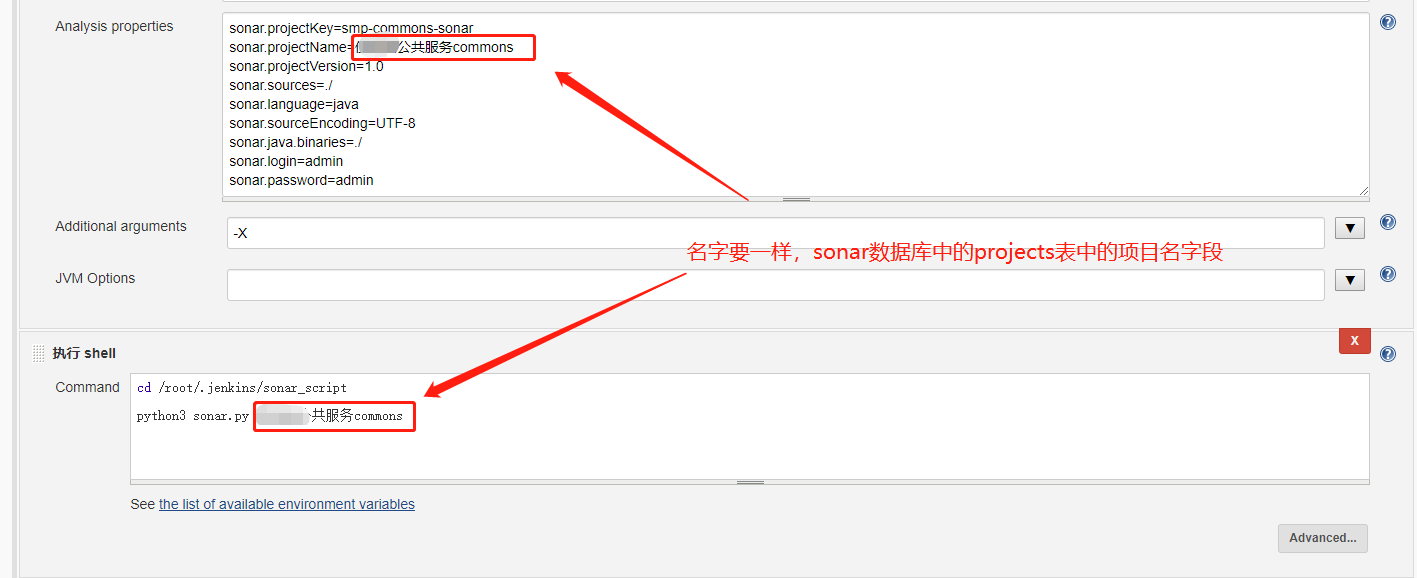
执行完成后会在/root/.jenkins/sonar_script目录下生成html文件,
10、配置发送邮件
10.1 安装插件:Email Extension
10.2 在系统管理》》系统设置中设置



11、发送邮件
在job中添加步骤

内容选择HTML,打开高级选项

增加触发器,并打开高级选项

输入发送邮箱列表,以英文逗号分隔,和邮件内容,html就是上面步骤生成的
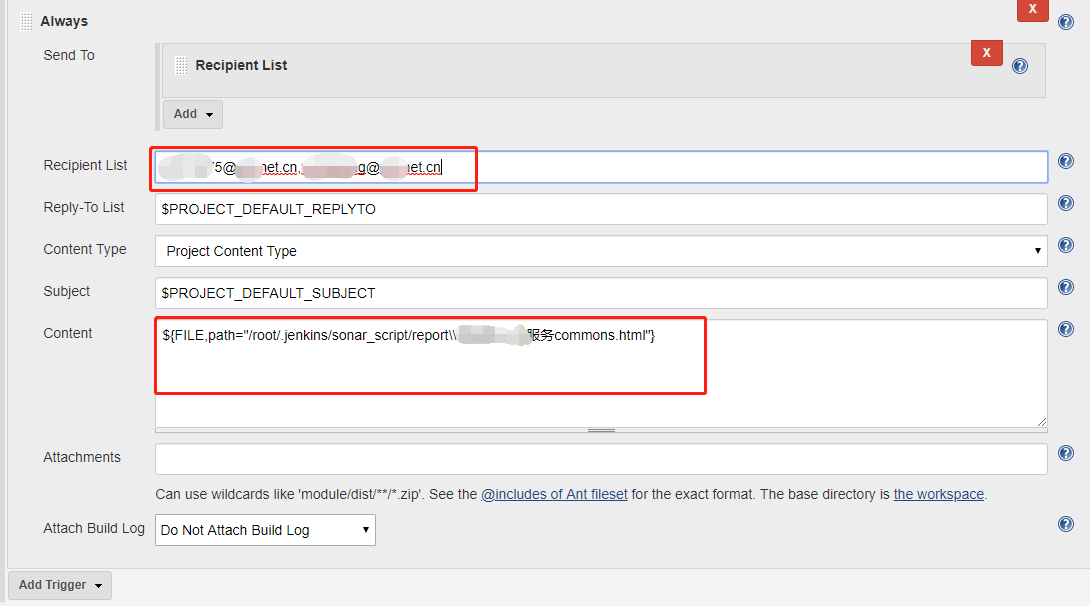
最终的邮件如下图:

jenkins:集成sonar代码扫描+发送邮件的更多相关文章
- jenkins集成sonar代码审核工具
在项目测试管理过程中,项目上线很多时候时间仓促,导致代码质量不高,测试时间不充分会导致线上出现各种各样的问题,这个时候一方面是增加测试的质量把控,还要从根本上解决开发小哥的代码质量问题.而Sonar这 ...
- Jenkins 集成Sonar代码质量扫描
Jenkins上安装插件 在jenkins插件安装界面安装: 插件名 SonarQube Scanner for Jenkins Jenkins上配置 jenkins中操作:系统管理-系统设置,找到 ...
- Jenkins之Sonar 代码检查
一.简介 SonarQube 是一个用于代码质量管理的开放平台.通过插件机制,Sonar 可以集成不同的测试工具,代码分析工具,以及持续集成工具.与持续集成工具(例如 Hudson/Jenkins 等 ...
- DEVOPS技术实践_11:Jenkins集成Sonar
前言 前面已经有介绍sonar的安装,简单应用,下面在简答的研究一下sonar和jenkins集成的简单使用,对于sonar的安装不做介绍 一 sonar的简单介绍 持续检查避免了低质量的代码,比如S ...
- 持续集成工具之jenkins+sonarqube做代码扫描
上一篇我们主要聊了下代码质量管理平台sonarqube的安装部署以及它的工作方式做了简单的描述和代码扫描演示:回顾请参考https://www.cnblogs.com/qiuhom-1874/p/13 ...
- Jenkins集成Sonar Quabe和权限配置
目录 安装Sonar Jenkins配置sonar Maven Jenkins Job配置 Pipeline Jenkins Job配置 Sonar权限管理 Sonar quality Gate通过阈 ...
- 03 . Jenkins构建之代码扫描
Sonar简介 Sonar 是一个用于代码质量管理的开放平台.通过插件机制,Sonar可以集成不同的测试工具,代码分析工具,以及持续集成工具.与持续集成工具(例如 Hudson/Jenkins 等)不 ...
- Jenkins 集成 Sonar
Jenkins 与 Sonar 集成:Sonar 是 Jenkins 之外独立运行的一个服务.Jenkins 中安装插件 SonarQube(并配置其 Sonar Server 的 URL / Acc ...
- jenkins集成sonar
用于我的sonar已经在一台机器上搭建好了,但是每次都要人工去执行sonar-run,很麻烦,所以就想着集成到jenkins上,在jenkins上点点按钮就可以看sonar结果,所以很抱歉,本博客不设 ...
随机推荐
- 5.7 zip 版本的安装 以及遇到的坑
https://blog.csdn.net/indexman/article/details/80291537 https://blog.csdn.net/weidong_y/article/deta ...
- c语言1博客作业11
一.本周作业头 这个作业属于那个课程 C语言程序设计II 这个作业要求在哪里 http://edu.cnblogs.com/campus/zswxy/SE2019-4/homework/10125 我 ...
- webclient上传下载文件
定义WebClient使用的操作类: 操作类名称WebUpDown WebClient上传文件至Ftp服务: //// <summary> /// WebClient上传文件至Ftp服务 ...
- 51nod 1843 排列合并机(DP+组合)
题解链接 不过求ggg不用O(n2)DPO(n^2)DPO(n2)DP,g[n]g[n]g[n]直接就是卡特兰数的第n−1n-1n−1项.即: g[n]=(2(n−1)n−1)−(2(n−1)n−2) ...
- python中闭包的概念
闭包:简单来说,就是一个外部函数的返回值是内部函数的引用 通过一个例子来说明 def outer(a): b = 10 def inner(): print(a+b) return inner # ...
- 【题解】球迷购票问题-C++
题目背景 盛况空前的足球赛即将举行.球赛门票售票处排起了球迷购票长龙. 按售票处规定,每位购票者限购一张门票,且每张票售价为50元.在排成长龙的球迷中有N个人手持面值50元的钱币,另有N个人手持面值1 ...
- Oracle 物理结构(二) 文件-口令文件
一.口令文件作用 1.口令文件基本介绍 Oracle数据库口令文件存放有超级用户的口令及其他特殊用户的用户名/口令. 口令文件在数据库创建时,自动创建,存放在$ORACLE_HOME/dbs. 此文件 ...
- Ubuntu14.04 支持 exFat 格式操作
推荐u盘使用exfat格式,为什么呢?两个原因: 1.三大主流操作系统(Linux.Mac.Windows)都支持exfat格式.2.exfat支持大于4G的文件. 在ubuntu下,由于版权的原因( ...
- C# 窗体 类似framest 左侧点击右侧显示 左侧菜单右侧显示
首先托一个splitContainer调节大小位置 然后进行再新创建一个窗体名为add 在左侧拖入button按钮 进入代码阶段 更改属性 public Main() { InitializeComp ...
- codeforces#1217D. Coloring Edges(图上染色)
题目链接: https://codeforces.com/contest/1217/problem/D 题意: 给图染上$k$种颜色,相同颜色不能形成一个环 数据范围: $1\leq n \leq 5 ...
